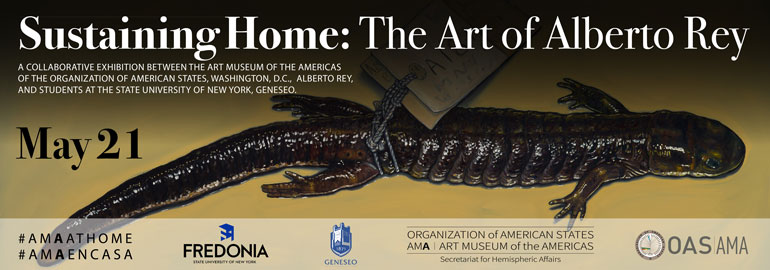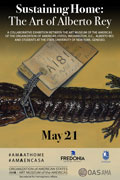
Azulmar Escalera is a Senior at SUNY Geneseo majoring in Art History, with a Minor in Museum Studies.
On social media May 22, 2021
Art and Identity
by Azulmar Escalera
The Cuban-American artist Alberto Rey dedicated much of his artistic career to understanding of his identity as a Cuban and an American. In so doing, Rey internalized his cultural identities through his art, giving visual expression to his exploration. Rey’s early subjects focused on highlighting the richness of Cuban culture and, specifically, on its diversity and how that diversity could shape/affect a person's identity/character as a whole. His work has also explored his American identity in contrast to his Cuban heritage.
Rey's explorations of his Cuban and American identities are manifested in approaches that focus on cultural issues and contemporary ecological concerns. I feel a connection to Rey’s works and to his exploration of his identity because I too share a Hispanic heritage, yet I am also an American, a New Yorker. As such, I can understand the instinctual pull to one's varying cultural identities in Rey’s work.
Historically, in American culture, there has been a lack of focus on Latin American/Hispanic art. Therefore, the works I selected from Rey’s body of work–individually and collectively–to me accentuate the variety within Hispanic heritage and communities. My goal has been to reflect on how Alberto Rey tackled such issues in his art and how his artistic identity reflects the rich and complex history of Hispanic art and culture. Alberto Rey’s works are testimony to his ability to create works of art that can enrich someone's life, and they are aesthetically and intellectually engaging and they speak to us all.
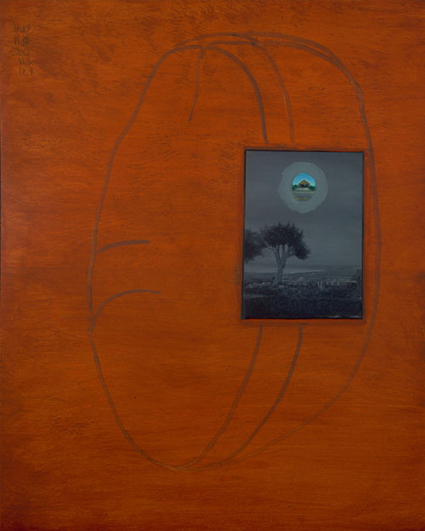
Madonnas in Time Series: Matanzas / Route 20 Garage, Westfield, New York, 1993, Oils on Wood, 30 x 36 x4”
Alberto Rey’s “The Madonnas in Time Series” incorporates images from old photographs, taken in Cuba during the 1910’s and 1920’s, preserved in the collection of the Cuban Heritage Collection at the University of Miami. Rey used those images as a background to contemporary scenes from the United States, from the area where he lived, in Western New York State, since 1989. In the “Madonnas in Time” Rey stayed away from politics and combined images of Cuba’s landscape with icons of American pop culture and from his surroundings. The images of Cuba are portrayed in black-and-white to reflect images of nostalgia, while the images of real life are presented in color to reflect the vibrancy of life and experience. Madonnas in Time Series: Matanzas/ Route 20 Garage captures the composition of varied identities by juxtaposing Western New York and Cuban landscapes. This reflects the dual reality of Rey’s world and the beauty that exists in both. The series presents both countries as a united identity, reflecting Rey’s own identity as a Cuban and an American. The series captures Rey’s Cuban past and his American present.
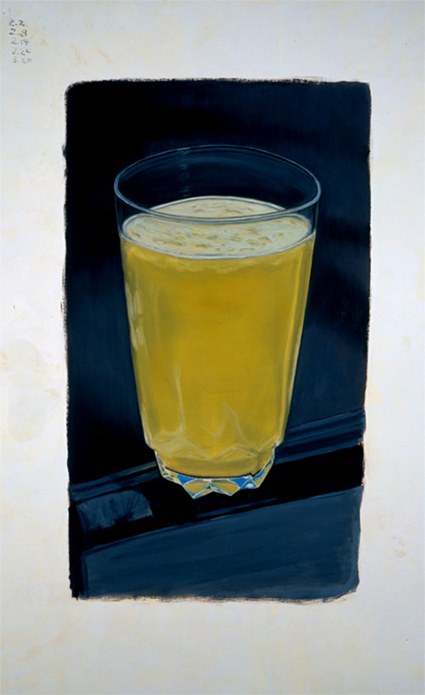
Icons Series: Guarapo (Sugar Cane Juice), 1993, Oils on Plaster, 96 x 60”
Alberto Rey’s Guarapo: (Sugar Cane Juice) is part of his “Cuban Icons Series” (1993-1995) series, in which he explored his Cuban culture by focusing on single specific objects that symbolize specific themes. The term “Guarapo'' refers to a Caribbean drink, most typically associated as a product of Cuba. Guarapo is made from freshly cut sugarcane, is popular and kept at the top of the list of drinks preferred by all ranks of Cuban society, as it is low in price, tastes good and has the power to refresh, with a pleasant taste. Guarapo intentionally reflects the artist's concentration of Cuban culture expressed through foods associated with Cuban culture. The painting was created on a fresco-like surface, using nontraditional applications of plaster rendered in a monumental scale, intentionally presenting every day, cultural objects in a format that had historically been used for “high” art. As such, Rey raised popular culture foods to a level of historical importance that lifted Cuban and Latin American culture to new territory of significance.
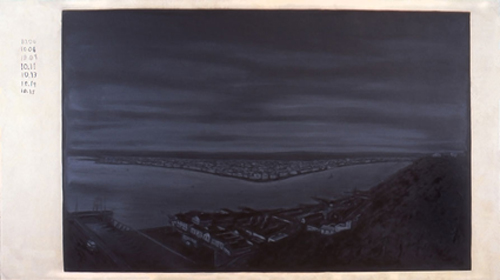
Appropriated Memories Series: Havana Harbor, 1996, Oils on Plaster, 48 x 84 x 4”
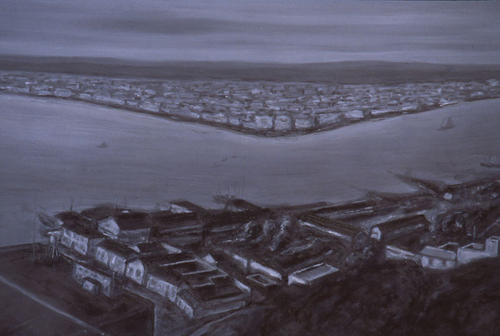
Detail of Appropriated Memories Series: Havana Harbor, 1996, Oils on Plaster, 48 x 84 x 4”
Alberto Rey’s Havana Harbor belongs to his “Appropriated Memories Series,” (1995-1997). In Havana Harbor, based on old photographs of Cuba’s harbor, Rey captured the feeling of fulfillment and spirituality often found in old images of places, which capture the sense of a lost time. In choosing a monochrome grayscale palette for the painting, Rey created an image reminiscent of the past by the use of a limited color palette, with a nostalgic feel that can be understood as a memory device. This nostalgic image presents a timeless image of Cuba without reference to political upheaval. By removing it from politics, Rey created an untainted, beautiful, aesthetic reminder of Cuba’s past before politics changed the context of Cuban culture.
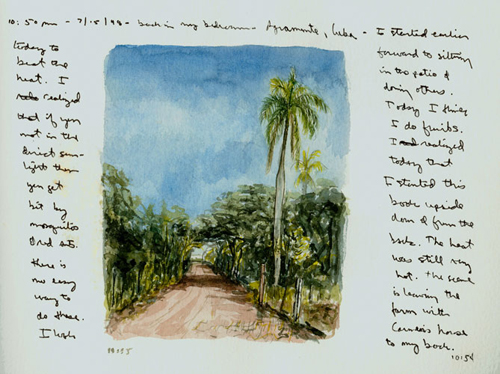
Family Farm, Agramonte, Cuba-Journal 1998, 1998, Watercolor and Ink on Paper, 5 x 8”
The scene, Family Farm, Agramonte, Cuba (1998), is part of a sketchbook, in which Alberto Rey documented the time he spent in Cuba, during his first trip to the island, with his mother to the family’s home in Agramonte, near Havana. In the Journal, Rey described how he became ill during the trip, suffering from a high fever, which gave him chills and hallucinations, made worse by the unrelenting heat. The watercolor painting itself displays the road leading to the family farm from the small nearby village along which Rey would bike. The painting captures the natural beauty and serenity of the island, simultaneously reflecting the common experience of Cuban people. As with his other series, featuring roads and landscapes, Family Farm emphasizes how, in many ways, we experience culture through the roads we travel.
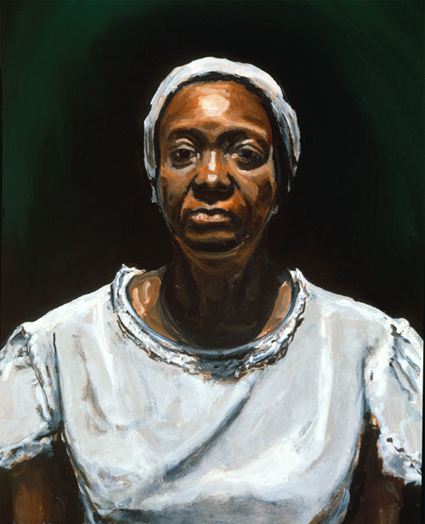
Detail of Cuban Portraits Series: Hilda, 1998, Oil on Wood, 15.5 x 12 x 2”
In creating his “Cuban Portraits Series” (1997-1999), Alberto Rey was influenced by the work of the Mexican, portrait-painter, Hermenegildo Bustos (1832 – 1907). As he worked on the series of portraits, Rey recorded the faces and personalities of Cubans he met, in Cuba and in the United States. Hilda is a portrait of one of the Cubans, who Rey met in his hometown of Agramonte, Cuba. The portrait effectively captures elements of the subject's character, economic class, and ethnicity. To me, the portrait reflects the deep rich Cuban heritage passed down through the generations. Hilda is painted in a devotional manner as a tribute to the experiences significant for Rey’s links to his Cuban identity. Hilda’s face reflects sincerity, wisdom and experience gained in life. Rey chose a beautiful and inspired color palette to display Hilda’s dark skin tone, alluding to her rich life experiences through color and through her powerful, almost regal, presence, accompanying her complex life. In this portrait, Rey presented Hilda as a friend and part of the family of Cubans, whom he recorded, with the intent of showing the Cuban people as a proud and strong people who have experienced and understand hardship and endurance as well as triumph.
Conclusion
Much of the work created by Alberto Rey addresses issues of identity on which he has focused during a life and career dedicated to understanding and reflecting on the complexities of identity. Accordingly, Rey has dedicated time to reflecting on how juxtaposing his cultural identities affected him as an individual. In so doing, Rey has also placed specific emphasis on aesthetically translating the strength, amplitude, intensity, and richness of Cuban culture through his art, as seen in the works included in this essay.

